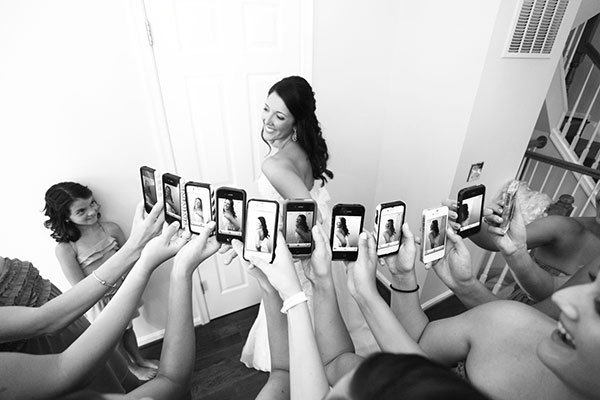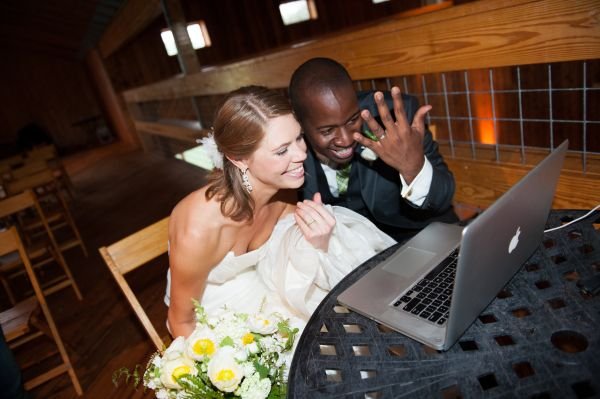
Photo Credit: CINEMATICbyDavidM
Do Not Use Email or Social Media For:
Wedding invitations. Emailing a wedding invitation, even to your closest friend or relative, generally is not appropriate. The wedding invitation serves to set the tone for the ceremony and reception to come in a way that an email just can’t. Pinned on refrigerators or tucked on mantels, they also act as reminders and help build anticipation. Lastly, for many guests, they are keepsakes. The only exception, and it’s quite rare, is in the case of extremely rushed circumstances — if, for example, you and your fiancé(e) are moving overseas and you’ve decided at the last minute to get married before you leave. A good way to judge is that if the invitation is so hurried or informal that your only other option would be to invite someone over the phone, then using email to extend the invitation would be probably be fine.
Thank-you notes.
For each wedding gift you receive, always pen a handwritten note and send it through the mail. No exceptions, unless you’re ship-wrecked on a desert island. If you’ve fallen behind on your note writing, or know you can’t write a note right away, you can send an email or private Facebook message as a stopgap measure to let the gift giver know you’ve received his or her gift and will be sending a formal thank-you soon. “So wonderful to see you at the wedding! We love the vase. Note to follow soon.” Just remember this message doesn’t replace the actual thank-you note.
Discussing personal or thorny issues.
It’s easy for communication over texting, Facebook, and email to be misconstrued, which can make working out compromises or resolving emotional conflicts difficult. You don’t have tone of voice or body language to help interpret or smooth over a difference of opinion. Despite the fact that you wrote the words, it’s also less personal than a direct conversation. If a tricky issue comes up, pick up the phone and call to talk it over, or arrange to meet face-to-face with those involved. It will get you back on the right track much more quickly than waiting for someone to reply. When others need to know personally, privately, or ahead of time.
Similarly, while it’s extremely convenient to be able to send group messages about wedding-related plans (“As mother of the groom, I’m pleased to invite you to a bridal shower for my future daughter-in-Iaw...”), it’s still important to check your plans personally with other key people first. Otherwise, you run the risk of ruffling feathers (“Well! As mother of the bride, I thought we were going to host the shower together!”) and putting a serious damper on the whole event.

Photo Credit: Cramer Photo on Scratch Weddings via Lover.ly
Use Email or Social Media For:
Aside from the specific instances cited previously, email and social media are generally acceptable options for wedding-related communications — including the following:"Save the Date” notices.
Many couples, once they’ve pinned down their wedding day, choose to send out an early informal note alerting friends and family to put that date aside. It’s perfectly fine to email this note.
Wedding RSVPs.
When sending out your wedding invi- tations, it is acceptable to give your guests the option of emailing their RSVPs to you. Simply add a sentence at the bottom of your printed response card saying, “Replies also welcome at happycouple@rsvp.com by (date).” This is especially appropriate in the case of a short turnaround time for responses, if you are planning a relatively informal wedding, or if you are already in regular email contact with a majority of your invited guests.
Wedding announcements.
Sure, lots of your friends in your Facebook world will know you got married, but you or your parents may have friends or more distant family who don’t keep in touch through social media. Typically, printed announcements are mailed after the wedding itself to friends and family who weren’t on the guest list as well as to acquaintances and business associates you think might wish to hear the news. While many couples and their parents still prefer this more formal way of sharing their happy news, it’s also acceptable to send wedding announcements out via email — particularly if you and the recipient are on infor- mal terms or if the wedding itself was informal. Use the bcc line on your email so that you don’t share recipients’ addresses, or use a service that gives you that option.
Invitations to informal or casual engagement parties, bridal showers, and other prewedding get-togethers.
These are all extremely important occasions, and most couples and their families will want to honor this fact by sending out printed invitations. Emailed invitations, or e-vitations, can be an acceptable alternative, however, particularly if you are planning an informal party or you’re sure the people on your guest list are computer-friendly. This is not the time to create a Facebook event, though — each invitation should be sent to the intended recipient.
Information on lodging and destination.
When sending out your wedding invitations, it’s fine to include an enclosure containing a map and directions for out-of-town guests. To avoid overloading the mailing and detracting from the invitation itself, however, it may make sense to include any other material — including information on hotels, restaurants, and points of local interest — in a separate mailing. For those of your guests who are online, a group email is ideal for this purpose. It’s also standard to include this information on a wedding website.
Wedding updates.
Many couples enjoy keeping their family and friends updated on the progress of their wedding plans. Group emails, Facebook, and Twitter are perfect for this sort of informal communication. Again, though, this convenience factor makes it all the more important to use common sense and consideration: Don’t flood the in-boxes of your entire guest list with daily news flashes and don’t share every tiny detail or development that are best saved for your clos- est friends. If you do decide to send out regular electronic updates, also send a printed copy to any friends and family who aren’t connected through email, Facebook, or Twitter.
Keep in mind proper group email etiquette. Begin any group emails to your guests with a general salutation — “Dear All” — and sign the email as you would on an individual message. To avoid annoying group “Reply All” messages and to respect guests’ privacy, use the “bcc” (blind carbon copy) feature. Put your email address in the “To” line and add your other addresses to the “bcc” line. Your guests’ email addresses will remain hidden and only your email will be available for a reply. Just be certain any guests who might not be online regularly receive the information they need in another form.
It’s not a bad idea to create an email list in your contacts for all of the wedding guests who have accepted your invitation. You may not need to use it, but if anything comes up at the last minute, such as a change in venue due to weather, it’s a quick way to reach a large group at once. Just be sure to remember to phone any guests who might not use email regularly, if at all.
—Anna Post and Lizzie Post, as seen in Emily Post’s Wedding Etiquette: 6th Edition. Published with permission from It Books/HarperColilns Publishers. © 2014 The Emily Post Institute.


0 comments:
Post a Comment